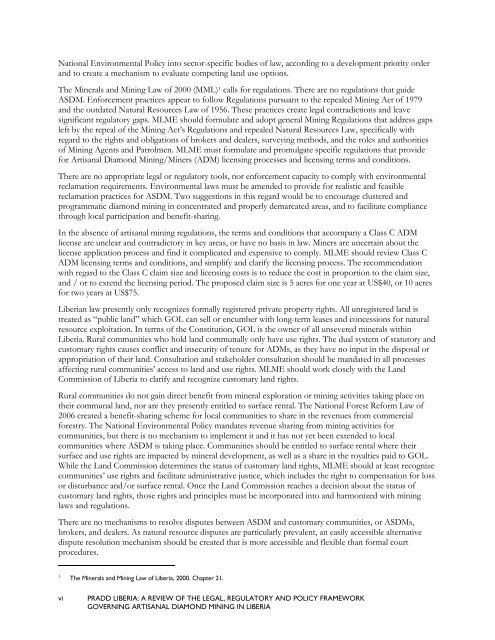(pradd) â liberia - Land Tenure and Property Rights Portal
(pradd) â liberia - Land Tenure and Property Rights Portal
(pradd) â liberia - Land Tenure and Property Rights Portal
- No tags were found...
Create successful ePaper yourself
Turn your PDF publications into a flip-book with our unique Google optimized e-Paper software.
National Environmental Policy into sector-specific bodies of law, according to a development priority order<strong>and</strong> to create a mechanism to evaluate competing l<strong>and</strong> use options.The Minerals <strong>and</strong> Mining Law of 2000 (MML) 1 calls for regulations. There are no regulations that guideASDM. Enforcement practices appear to follow Regulations pursuant to the repealed Mining Act of 1979<strong>and</strong> the outdated Natural Resources Law of 1956. These practices create legal contradictions <strong>and</strong> leavesignificant regulatory gaps. MLME should formulate <strong>and</strong> adopt general Mining Regulations that address gapsleft by the repeal of the Mining Act’s Regulations <strong>and</strong> repealed Natural Resources Law, specifically withregard to the rights <strong>and</strong> obligations of brokers <strong>and</strong> dealers, surveying methods, <strong>and</strong> the roles <strong>and</strong> authoritiesof Mining Agents <strong>and</strong> Patrolmen. MLME must formulate <strong>and</strong> promulgate specific regulations that providefor Artisanal Diamond Mining/Miners (ADM) licensing processes <strong>and</strong> licensing terms <strong>and</strong> conditions.There are no appropriate legal or regulatory tools, nor enforcement capacity to comply with environmentalreclamation requirements. Environmental laws must be amended to provide for realistic <strong>and</strong> feasiblereclamation practices for ASDM. Two suggestions in this regard would be to encourage clustered <strong>and</strong>programmatic diamond mining in concentrated <strong>and</strong> properly demarcated areas, <strong>and</strong> to facilitate compliancethrough local participation <strong>and</strong> benefit-sharing.In the absence of artisanal mining regulations, the terms <strong>and</strong> conditions that accompany a Class C ADMlicense are unclear <strong>and</strong> contradictory in key areas, or have no basis in law. Miners are uncertain about thelicense application process <strong>and</strong> find it complicated <strong>and</strong> expensive to comply. MLME should review Class CADM licensing terms <strong>and</strong> conditions, <strong>and</strong> simplify <strong>and</strong> clarify the licensing process. The recommendationwith regard to the Class C claim size <strong>and</strong> licensing costs is to reduce the cost in proportion to the claim size,<strong>and</strong> / or to extend the licensing period. The proposed claim size is 5 acres for one year at US$40, or 10 acresfor two years at US$75.Liberian law presently only recognizes formally registered private property rights. All unregistered l<strong>and</strong> istreated as “public l<strong>and</strong>” which GOL can sell or encumber with long-term leases <strong>and</strong> concessions for naturalresource exploitation. In terms of the Constitution, GOL is the owner of all unsevered minerals withinLiberia. Rural communities who hold l<strong>and</strong> communally only have use rights. The dual system of statutory <strong>and</strong>customary rights causes conflict <strong>and</strong> insecurity of tenure for ADMs, as they have no input in the disposal orappropriation of their l<strong>and</strong>. Consultation <strong>and</strong> stakeholder consultation should be m<strong>and</strong>ated in all processesaffecting rural communities’ access to l<strong>and</strong> <strong>and</strong> use rights. MLME should work closely with the <strong>L<strong>and</strong></strong>Commission of Liberia to clarify <strong>and</strong> recognize customary l<strong>and</strong> rights.Rural communities do not gain direct benefit from mineral exploration or mining activities taking place ontheir communal l<strong>and</strong>, nor are they presently entitled to surface rental. The National Forest Reform Law of2006 created a benefit-sharing scheme for local communities to share in the revenues from commercialforestry. The National Environmental Policy m<strong>and</strong>ates revenue sharing from mining activities forcommunities, but there is no mechanism to implement it <strong>and</strong> it has not yet been extended to localcommunities where ASDM is taking place. Communities should be entitled to surface rental where theirsurface <strong>and</strong> use rights are impacted by mineral development, as well as a share in the royalties paid to GOL.While the <strong>L<strong>and</strong></strong> Commission determines the status of customary l<strong>and</strong> rights, MLME should at least recognizecommunities’ use rights <strong>and</strong> facilitate administrative justice, which includes the right to compensation for lossor disturbance <strong>and</strong>/or surface rental. Once the <strong>L<strong>and</strong></strong> Commission reaches a decision about the status ofcustomary l<strong>and</strong> rights, those rights <strong>and</strong> principles must be incorporated into <strong>and</strong> harmonized with mininglaws <strong>and</strong> regulations.There are no mechanisms to resolve disputes between ASDM <strong>and</strong> customary communities, or ASDMs,brokers, <strong>and</strong> dealers. As natural resource disputes are particularly prevalent, an easily accessible alternativedispute resolution mechanism should be created that is more accessible <strong>and</strong> flexible than formal courtprocedures.1The Minerals <strong>and</strong> Mining Law of Liberia, 2000. Chapter 21.viPRADD LIBERIA: A REVIEW OF THE LEGAL, REGULATORY AND POLICY FRAMEWORKGOVERNING ARTISANAL DIAMOND MINING IN LIBERIA
















